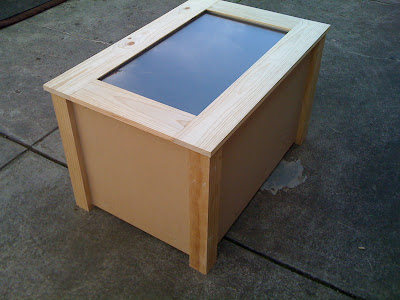
















The DSI Project - Demo Reel from Paul D'Intino on Vimeo.



3-Port Motorised USB Hub from Paul D'Intino on Vimeo.














TouchWWJ First Test from Paul D'Intino on Vimeo.















// Arduino Simple Moisture Tester
// By Paul D'Intino
// Feb 11 2010
//initialize values
int moistureSensor = 0;
int moisture_val;
int lightSwitch1 = 35;
int lightSwitch2 = 37;
int lightSwitch3 = 39;
int lightSwitch4 = 41;
int lightSwitch5 = 43;
int lightSwitch6 = 45;
int lightSwitch7 = 47;
int lightSwitch8 = 49;
int lightSwitch9 = 51;
int lightSwitch10 = 53;
void setup() {
Serial.begin(9600); //open serial port
//setup Digital pins as Outputs
pinMode (lightSwitch1, OUTPUT);
pinMode (lightSwitch2, OUTPUT);
pinMode (lightSwitch3, OUTPUT);
pinMode (lightSwitch4, OUTPUT);
pinMode (lightSwitch5, OUTPUT);
pinMode (lightSwitch6, OUTPUT);
pinMode (lightSwitch7, OUTPUT);
pinMode (lightSwitch8, OUTPUT);
pinMode (lightSwitch9, OUTPUT);
pinMode (lightSwitch10, OUTPUT);
//set all the LEDS to OFF on startup
digitalWrite (lightSwitch1, LOW);
digitalWrite (lightSwitch2, LOW);
digitalWrite (lightSwitch3, LOW);
digitalWrite (lightSwitch4, LOW);
digitalWrite (lightSwitch5, LOW);
digitalWrite (lightSwitch6, LOW);
digitalWrite (lightSwitch7, LOW);
digitalWrite (lightSwitch8, LOW);
digitalWrite (lightSwitch9, LOW);
digitalWrite (lightSwitch10, LOW);
}
void loop() {
moisture_val = analogRead(moistureSensor); // read the value from the moisture-sensing probes
Serial.print("moisture sensor reads "); //output the value from the sensors
Serial.println( moisture_val );
//Step 1 - setup the maximum value with all LEDS on
if (moisture_val >= 1000 )
{
digitalWrite(lightSwitch1, HIGH);
digitalWrite(lightSwitch2, HIGH);
digitalWrite(lightSwitch3, HIGH);
digitalWrite(lightSwitch4, HIGH);
digitalWrite(lightSwitch5, HIGH);
digitalWrite(lightSwitch6, HIGH);
digitalWrite(lightSwitch7, HIGH);
digitalWrite(lightSwitch8, HIGH);
digitalWrite(lightSwitch9, HIGH);
digitalWrite(lightSwitch10, HIGH);
delay(10);
}
//Step 2
else if (moisture_val >= 800 && moisture_val <= 900 )
{
digitalWrite(lightSwitch1, HIGH);
digitalWrite(lightSwitch2, HIGH);
digitalWrite(lightSwitch3, HIGH);
digitalWrite(lightSwitch4, HIGH);
digitalWrite(lightSwitch5, HIGH);
digitalWrite(lightSwitch6, HIGH);
digitalWrite(lightSwitch7, HIGH);
digitalWrite(lightSwitch8, HIGH);
digitalWrite(lightSwitch9, HIGH);
digitalWrite(lightSwitch10, LOW);
delay(10);
}
//Step 3
else if (moisture_val >= 700 && moisture_val <= 800 )
{
digitalWrite(lightSwitch1, HIGH);
digitalWrite(lightSwitch2, HIGH);
digitalWrite(lightSwitch3, HIGH);
digitalWrite(lightSwitch4, HIGH);
digitalWrite(lightSwitch5, HIGH);
digitalWrite(lightSwitch6, HIGH);
digitalWrite(lightSwitch7, HIGH);
digitalWrite(lightSwitch8, HIGH);
digitalWrite(lightSwitch9, LOW);
digitalWrite(lightSwitch10, LOW);
delay(10);
}
//Step 4
else if (moisture_val >= 600 && moisture_val <= 700 )
{
digitalWrite(lightSwitch1, HIGH);
digitalWrite(lightSwitch2, HIGH);
digitalWrite(lightSwitch3, HIGH);
digitalWrite(lightSwitch4, HIGH);
digitalWrite(lightSwitch5, HIGH);
digitalWrite(lightSwitch6, HIGH);
digitalWrite(lightSwitch7, HIGH);
digitalWrite(lightSwitch8, LOW);
digitalWrite(lightSwitch9, LOW);
digitalWrite(lightSwitch10, LOW);
delay(10);
}
//Step 5
else if (moisture_val >= 500 && moisture_val <= 600 )
{
digitalWrite(lightSwitch1, HIGH);
digitalWrite(lightSwitch2, HIGH);
digitalWrite(lightSwitch3, HIGH);
digitalWrite(lightSwitch4, HIGH);
digitalWrite(lightSwitch5, HIGH);
digitalWrite(lightSwitch6, HIGH);
digitalWrite(lightSwitch7, LOW);
digitalWrite(lightSwitch8, LOW);
digitalWrite(lightSwitch9, LOW);
digitalWrite(lightSwitch10, LOW);
delay(10);
}
//Step 6
else if (moisture_val >= 400 && moisture_val <= 500 )
{
digitalWrite(lightSwitch1, HIGH);
digitalWrite(lightSwitch2, HIGH);
digitalWrite(lightSwitch3, HIGH);
digitalWrite(lightSwitch4, HIGH);
digitalWrite(lightSwitch5, HIGH);
digitalWrite(lightSwitch6, LOW);
digitalWrite(lightSwitch7, LOW);
digitalWrite(lightSwitch8, LOW);
digitalWrite(lightSwitch9, LOW);
digitalWrite(lightSwitch10, LOW);
delay(10);
}
//Step 7
else if (moisture_val >= 300 && moisture_val <= 400 )
{
digitalWrite(lightSwitch1, HIGH);
digitalWrite(lightSwitch2, HIGH);
digitalWrite(lightSwitch3, HIGH);
digitalWrite(lightSwitch4, HIGH);
digitalWrite(lightSwitch5, LOW);
digitalWrite(lightSwitch6, LOW);
digitalWrite(lightSwitch7, LOW);
digitalWrite(lightSwitch8, LOW);
digitalWrite(lightSwitch9, LOW);
digitalWrite(lightSwitch10, LOW);
delay(10);
}
//Step 8
else if (moisture_val >= 200 && moisture_val <= 300 )
{
digitalWrite(lightSwitch1, HIGH);
digitalWrite(lightSwitch2, HIGH);
digitalWrite(lightSwitch3, HIGH);
digitalWrite(lightSwitch4, LOW);
digitalWrite(lightSwitch5, LOW);
digitalWrite(lightSwitch6, LOW);
digitalWrite(lightSwitch7, LOW);
digitalWrite(lightSwitch8, LOW);
digitalWrite(lightSwitch9, LOW);
digitalWrite(lightSwitch10, LOW);
delay(10);
}
//Step 9
else if (moisture_val >= 100 && moisture_val <= 200 )
{
digitalWrite(lightSwitch1, HIGH);
digitalWrite(lightSwitch2, HIGH);
digitalWrite(lightSwitch3, LOW);
digitalWrite(lightSwitch4, LOW);
digitalWrite(lightSwitch5, LOW);
digitalWrite(lightSwitch6, LOW);
digitalWrite(lightSwitch7, LOW);
digitalWrite(lightSwitch8, LOW);
digitalWrite(lightSwitch9, LOW);
digitalWrite(lightSwitch10, LOW);
delay(10);
}
//Step10 - setup the minimum value with all LEDS off but one Red LED.
else
{
digitalWrite(lightSwitch1, HIGH);
digitalWrite(lightSwitch2, LOW);
digitalWrite(lightSwitch3, LOW);
digitalWrite(lightSwitch4, LOW);
digitalWrite(lightSwitch5, LOW);
digitalWrite(lightSwitch6, LOW);
digitalWrite(lightSwitch7, LOW);
digitalWrite(lightSwitch8, LOW);
digitalWrite(lightSwitch9, LOW);
digitalWrite(lightSwitch10, LOW);
delay(10);
}
}


